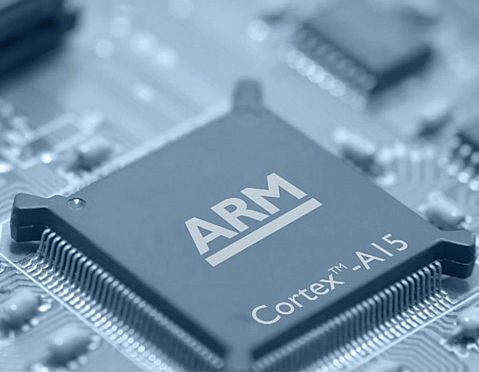Calxeda is adding to the burgeoning competition between Intel and ARM Holdings with a demonstration this week of an ARM-based server running a Linux operating system.
Calxeda, which last autumn announced a partnership with Hewlett-Packard to develop very low-power systems running on ARM-based processors, on 7 May showed off the prototype server powered by its EnergyCard compute blades at the Ubuntu Developer and Cloud Summit in Oakland, California. The system ran the Ubuntu 12.04 operating system, running a LAMP (Linux, Apache, MySQL, PHP) software stack running the company’s website, as well as other software, including Ruby-on-Rails.
Step forward
Karl Freund, Calxeda’s vice president of marketing, said the demonstration was a significant step forward for the ARM-in-servers push, and said more such demonstrations were on the way, with end-user shipments starting in four to eight weeks and volume shipments from HP and other vendors this fall.
“This is the real deal,” Freund wrote in a blog post. “[Q]uad-core, w/ 4MB cache, secure management engine, and Calxeda’s fabric all up and running.”
 Intel has been looking to make inroads into the rapidly growing mobile device space currently dominated by chips designed by ARM and made by Samsung Electronics, Nvidia, Qualcomm and others. At the same time, ARM and some manufacturing partners – including Calxeda, Marvell Technologies and Nvidia – have been eyeing the server space, believing that their low-power chips would be ideal for energy-efficient servers aimed at such workloads as web 2.0, high-performance computing (HPC) and cloud computing.
Intel has been looking to make inroads into the rapidly growing mobile device space currently dominated by chips designed by ARM and made by Samsung Electronics, Nvidia, Qualcomm and others. At the same time, ARM and some manufacturing partners – including Calxeda, Marvell Technologies and Nvidia – have been eyeing the server space, believing that their low-power chips would be ideal for energy-efficient servers aimed at such workloads as web 2.0, high-performance computing (HPC) and cloud computing.
Forrester analyst Richard Fichera has been talking about the significance of ARM pushing its way up the ladder and into the data centre, and wrote in a 7 May blog post that Calxeda’s demonstration was an important step.
“It proves that Calxeda can indeed deliver a working server based on its scalable fabric architecture, although having HP signing up as a partner meant that this was essentially a nonissue, but still, proof is good,” Fichera wrote. “It also establishes that at least one Linux distribution provider, in this case Ubuntu, is willing to provide a real supported distribution. My guess is that Red Hat and Centos will jump on the bus fairly soon as well. Most importantly, we can get on with the important work of characterising real benchmarks on real systems with real OS support.”
Web-based companies like Facebook and Google, which run massive, highly dense data centres that push through huge amounts of small workloads, have been at the forefront pushing for highly efficient servers that can help drive down power and operating costs. ARM officials see this as a perfect fit for their chip designs, and have said they expect to start gaining traction in 2014.
Performance and energy efficiency
However, both Intel and Advanced Micro Devices have made strides in increasing both the performance and energy efficiency of their chips, and Fichera said those efforts are paying off.
Calxeda’s demonstration is not “a slam dunk guaranteed win [for ARM]”, he wrote. “Intel has been steadily ratcheting up its energy efficiency, and the latest generation of x86 servers from HP, IBM, Dell and others show promise of much better throughput per watt than their predecessors. Add to that the demonstration of a Xeon-based system by Sea Micro (ironically now owned by AMD) that delivered Xeon CPUs at a 10 W per CPU power overhead, an unheard of efficiency.
“But this kind of competition is what drives the technology business, and the outcome of this skirmish will in the end benefit anyone who needs a server in the coming years with increased options and continued pressure on incumbents to do better.”
SeaMicro has been making highly dense servers based on Intel’s low-power Atom platform for several years, and earlier this year demonstrated energy-efficient systems running on Xeon chips. Less than two months later, AMD bought SeaMicro for $334 million (£207m).
Ivy Bridge
Intel also is pushing a high-performance, high-efficiency story with its new 22-nanometre Ivy Bridge architecture, which features the company’s new three-dimensional Tri-Gate transistor architecture. Dell on 8 May introduced its first microserver powered by Intel’s upcoming Ivy Bridge Xeons.
Still, ARM’s server efforts have gained the attention of OEMs, who are sensitive to their customers’ power concerns. HP’s partnership with Calxeda is part of its larger Project Moonshot effort to develop highly efficient systems. In addition, Dell officials have said they have ARM-based systems running in their labs.
Forrest Norrod, vice president and general manager of Dell Server Platforms, last year questioned whether ARM’s window of opportunity in the server business may have closed a bit, given the strides Intel and AMD have made in power efficiency.
However, Hans Mosesmann, an analyst with Raymond James Equity Research, said in a 9 May research note that ARM increasingly will be a player in the server space.
“ARM multi-core is increasingly becoming a topic of desire by the likes of Google, Facebook and even Cisco in Silicon Valley,” Mosesmann wrote. “We expect silicon road maps to be solidified over the next 1-2 years as SoC [system-on-a-chip] development gels and 64-bit [in ARM chips] becomes more stable. Note that unlike the MIPS and PowerPC architectures that are compute-intensive and scale well, ARM is very efficient for certain workloads.”
How well do you know your operating systems? Take our quiz.





